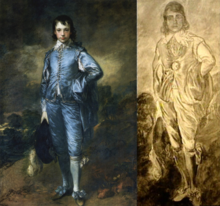fiction.wikisort.org - Movie
The Boy in Blue (German: Der Knabe in Blau and also known as Emerald of Death) is a 1919 silent German drama film directed by F. W. Murnau. It was Murnau's directorial debut. The film is now considered to be a lost film,[1] though the Deutsche Kinemathek film archive possesses 35 small fragments ranging from two to eleven frames in length.[2]
| The Boy in Blue | |
|---|---|
 Advertisement | |
| Directed by | F. W. Murnau |
| Written by | Edda Ottershausen |
| Produced by | Ernst Hofmann |
| Starring | Ernst Hofmann |
| Cinematography | |
Release date |
|
Running time | 54 minutes |
| Country | Weimar Republic |
| Languages |
|

Thomas Gainsborough's painting The Blue Boy and Oscar Wilde's novel The Picture of Dorian Gray were inspirations for Murnau to create this film.[3]
Plot
Thomas von Weerth (Ernst Hofmann) is a poverty-stricken aristocrat who lives in his broken-down castle with a single old servant (Karl Platen). His sole expensive remaining possession is a painting of an ancestor (similar to Thomas Gainsborough's painting The Blue Boy), which depicts the ancestor wearing a gigantic emerald. According to family myth, the emerald is cursed, and the son of the ancestor hid the emerald somewhere in the castle to stop the curse. Weerth has been searching for it for years.
One night, Weerth dreams that his ancestor steps out of the painting and shows him where the emerald is. The next morning, Weerth goes to the spot and indeed finds the emerald. The servant pleads with him to throw it away, but he refuses.
That night, a roving band of gypsies comes to the castle. They sing, dance, and put on skits for von Weerth, who falls instantly in love with a blonde gypsy girl (Blandine Ebinger). As she forces von Weerth to dance attendance on her, the rest of the gypsies steal the emerald and everything else in the castle and set fire to the building. The gypsy girl laughs as she and her comrades flee.
Von Weerth falls seriously ill. A young gypsy actress (Margit Barnay), however, fell in love with von Weerth. She now returns, nurses him back to health, and they fall in love.[4]
Cast
- Ernst Hofmann as Thomas von Weerth
- Blandine Ebinger as Schöne Zigeunerin / Fair gypsy
- Margit Barnay as Junge Schauspielerin / Young actress
- Karl Platen as Alter Diener / Old servant
- Georg John as Zigeuner-Hauptmann / Gypsy commander
- Leonhard Haskel as Theaterdirektor
- Marie von Buelow as Bettlerin
- Rudolf Klix as Bobby
- Hedda Kemp as Dame im Schleier
- Hans Otterhausen as Guckkastenmann
- Hans Schaup as Der alte Dietrich / Thomas' Diener
See also
- List of lost films
References
- "Silent Era : Progressive Silent Film List". www.silentera.com. Retrieved 19 September 2021.
- "Der Knabe in Blau". Deutsche Kinemathek. Retrieved 25 March 2013.
- Bock, Hans-Michael; Bergfelder, Tim, eds. (2009). The Concise Cinegraph: Encyclopaedia of German Cinema. New York: Berghahn Books. p. 334. ISBN 978-1-57181-655-9.
- Eisner, Lotte H. (1973). Murnau. Berkeley, Calif.: University of California Press. pp. 122–123. ISBN 9780520022850.
External links
![]() Media related to Der Knabe in Blau at Wikimedia Commons
Media related to Der Knabe in Blau at Wikimedia Commons
- The Boy in Blue at IMDb
На других языках
[de] Der Knabe in Blau
Der Knabe in Blau (Alternativtitel: Der Todessmaragd)[1] ist (vermutlich) der erste Film von Friedrich Wilhelm Murnau. Der Film aus dem Jahr 1919 wurde möglicherweise nie öffentlich gezeigt und gilt als verschollen.- [en] The Boy in Blue (1919 film)
Другой контент может иметь иную лицензию. Перед использованием материалов сайта WikiSort.org внимательно изучите правила лицензирования конкретных элементов наполнения сайта.
WikiSort.org - проект по пересортировке и дополнению контента Википедии